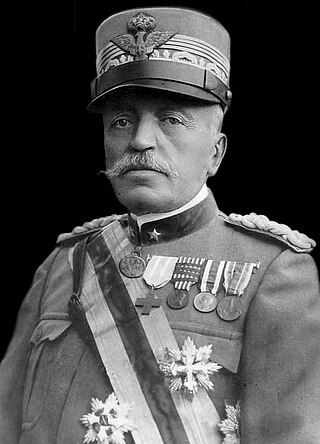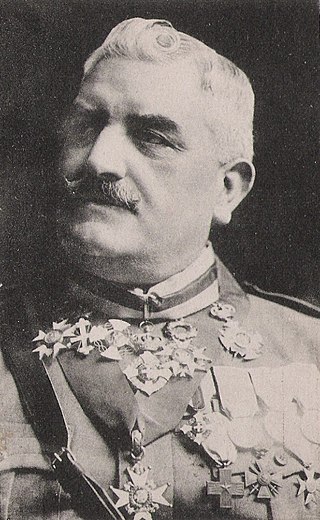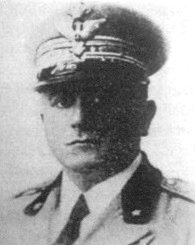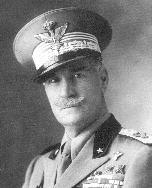
Pietro Badoglio, 1st Duke of Addis Abeba, 1st Marquess of Sabotino, was an Italian general during both World Wars and the first viceroy of Italian East Africa. With the fall of the Fascist regime in Italy, he became Prime Minister of Italy.

Ugo Cavallero was an Italian military commander before and during World War II. He was dismissed from his command due to his lacklustre performance, and was arrested upon the fall of Benito Mussolini's regime. Cavallero was later freed by the Germans, but refused to collaborate and was found dead the following day.

Marshal of Italy Luigi Cadorna, was an Italian general, Marshal of Italy and Count, most famous for being the Chief of Staff of the Italian Army from 1914 until 1917 during World War I. During this period, commanding the Italian army on the Alpine front and along the Isonzo river, he acquired a reputation for rigid discipline and the harsh treatment of his troops. Cadorna achieved successes in containing the Strafexpedition and capturing Gorizia but, following a major defeat at the Battle of Caporetto in late 1917, he was relieved as Chief of Staff.

The Battle of Vittorio Veneto was fought from 24 October to 3 November 1918 near Vittorio Veneto on the Italian Front during World War I. After having thoroughly defeated Austro-Hungarian troops during the defensive Battle of the Piave River, the Italian army launched a great counter-offensive: the Italian victory marked the end of the war on the Italian Front, secured the dissolution of the Austro-Hungarian Empire and contributed to the end of the First World War just one week later. On 1 November, the new Hungarian government of Count Mihály Károlyi decided to recall all of the troops, who were conscripted from the territory of Kingdom of Hungary, which was a major blow for the Habsburgs' armies. The battle led to the capture of over 5,000 artillery pieces and over 350,000 Austro-Hungarian troops, including 120,000 Germans, 83,000 Czechs and Slovaks, 60,000 South Slavs, 40,000 Poles, several tens of thousands of Romanians and Ukrainians, and 7,000 Austro-Hungarian loyalist Italians and Friulians.

The Italian Regency of Carnaro was a self-proclaimed state in the city of Fiume led by Gabriele d'Annunzio between 1919 and 1920.

Gaetano Giardino was an Italian soldier that rose to the rank of Marshal of Italy and Italian Representative to the Allied War Council during World War I.

Pietro Micheletti was an Italian military commander.
The Bloody Christmas of 1920 was a series of clashes in Fiume, which led to the conclusion of the Fiume campaign that was carried out by the Italian poet and adventurer Gabriele D'Annunzio in 1920.
Marshal Guglielmo Pecori Giraldi, OSSA, OSML, OMS, OCI was an Italian noble, general and politician, mostly known for commanding the Italian 1st Army during World War I.

Wenzel Freiherr von Wurm was a Colonel General in the Austro-Hungarian Army.

Vincenzo Garioni was an Italian general who saw combat in the Boxer Rebellion, Italo-Turkish War, and World War I. He was the governor of Tripolitania from 1913 to 1914 and later served as the governor of both Tripolitania and Cyrenaica from 1918 to 1919.

Luca Montuori was an Italian general during World War I.
Giuseppe Daodice was an Italian general. He was the 6th Italian governor of Addis Ababa and 3rd Italian governor of Scioa (1940–1941). He was a knight of the Order of Saints Maurice and Lazarus.

Antonio Sorice was an Italian general during World War II, Undersecretary for War from February to July 1943 and Minister of War from July 1943 to February 1944.

Giuseppe Pennella (1864-1925) was an Italian lieutenant general who was a highly decorated officer of the Royal Italian Army. During the First World War, he held very high positions, commanding in succession: the "Grenadiers of Sardinia" Brigade, 35th Division, XI Army Corps, 2nd Army, 8th Army and XII Army Corps. At the head of the 35th Division, he operated in the Macedonian front, but was relieved of command at the request of the French general Sarrail, who was commander of the Armée d'Orient, as both had a strong disagreement over command.

Vittorio Sogno was an Italian general during World War II.

Federico Baistrocchi was an Italian general during the interwar period and World War II. He served as State Undersecretary for War from 1933 to 1936 and as Chief of Staff of the Royal Italian Army from 1934 to 1936. He was also a member of the Chamber of Deputies and of the Senate of the Kingdom of Italy.

Francesco Saverio Grazioli was an Italian general and politician who was a Senator of the Kingdom of Italy from May 10, 1929, to August 5, 1943. He was also a veteran of World War I, commanding the VIII Corps during the Italian front and at the Battle of Caporetto.
Giuseppe Pavone was an Italian general during the interwar period and World War II.

Antonino Di Giorgio was an Italian general and politician, who fought in the First Italo-Ethiopian War, the Italo-Turkish War and the First World War, and served as Minister of War of the Kingdom of Italy from April 1924 to April 1925. He resigned after the rejection of his plan for a radical reform of the Royal Italian Army.



















